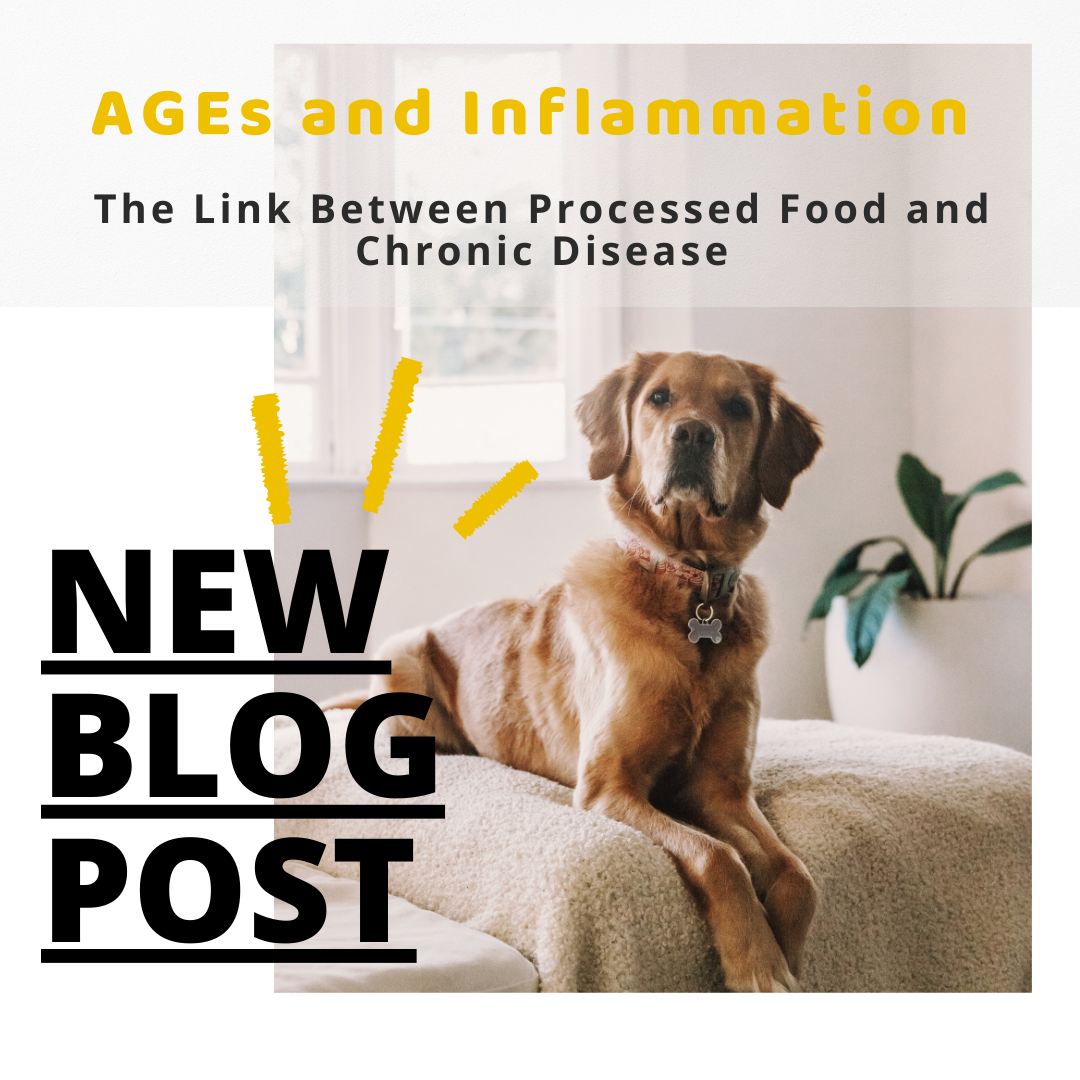When customers ask us to recommend a kibble, our honest answer is, “none of them.” Why? Because it’s not just about the ingredients; it’s about the intense processing these foods go through to make it into that crunchy little pellet.
When customers ask us to recommend a kibble, our honest answer is, “none of them.” Why? Because it’s not just about the ingredients; it’s about the intense processing these foods go through to make it into that crunchy little pellet. The methods of manufacture, which include extremely high temperatures, is where we believe the real risks to your dog’s health begin.
In our search for the best nutrition, we often overlook something hidden in plain sight—Advanced Glycation End Products, or AGEs. These compounds form when foods are cooked at high temperatures, and they’re more common in pet foods than you might think. While they’re best known for adding flavor and a browning color, AGEs can also drive inflammation, oxidative stress, and even chronic disease. From kibble to canned meals, the AGEs in processed dog foods may be impacting your pet’s health in ways that go unnoticed until symptoms arise. Let’s dive into the science of AGEs and why a fresh, less processed diet may be a step toward a healthier, happier pet.
Exposing the body to AGEs from processed foods has been linked to many human health issues, and considering these same biological reactions occur in our pets, it’s not far-fetched to wonder: could AGEs be fueling the rise in chronic illnesses we’re seeing in pets, too? The following dives into what happens in the body when it’s exposed to AGEs from food. Though the research is still unfolding, it’s an eye-opening area of science that could hold the key to understanding many unexplained diseases.
Formation and Ingestion of AGEs
AGEs are formed through a chemical reaction called the Maillard Reaction, where sugars non-enzymatically bind to proteins or lipids. This reaction is accelerated by high temperatures, making foods like grilled meats, processed foods, and other heat-processed items particularly high in AGEs. Ingestion of these dietary AGEs means they enter the digestive system, where a portion is absorbed into the bloodstream.
Mechanisms of AGE-Induced Damage in the Body
Once AGEs are absorbed, they begin to affect the body in several interconnected ways:
-
Interaction with RAGE (Receptor for Advanced Glycation End Products):
- AGEs bind to specific receptors on cell surfaces, mainly the Receptor for Advanced Glycation End Products (RAGE), which is expressed in high amounts on immune cells, endothelial cells, and in various tissues prone to inflammatory damage.
- The binding of AGEs to RAGE activates multiple intracellular signaling pathways, particularly the NF-κB (nuclear factor-kappa B) pathway, a major regulator of inflammation and immune response.
-
Activation of Pro-Inflammatory Pathways:
- When AGEs bind to RAGE, it stimulates the production of pro-inflammatory cytokines. These cytokines amplify the inflammatory response, promoting a low-grade chronic inflammatory state.
- In addition, AGE-RAGE interaction increases the production of reactive oxygen species (ROS), which are free radicals that further contribute to oxidative stress in cells. Excessive ROS can damage proteins, lipids, and DNA, leading to cellular dysfunction and apoptosis (cell death).
-
Oxidative Stress and Mitochondrial Dysfunction:
- Oxidative stress from AGE-induced ROS production disrupts mitochondrial function, which is crucial for cellular energy production and metabolism. Mitochondrial dysfunction due to oxidative damage reduces the cell’s ability to generate energy efficiently and accelerates cell aging and apoptosis.
- In tissues with high energy demands, such as the gut lining, heart, and kidneys, this oxidative stress can lead to more rapid tissue damage and contribute to organ-specific diseases.
-
Endothelial Dysfunction and Vascular Damage:
- AGEs accumulate in blood vessels, where they cross-link with structural proteins like collagen and elastin. This cross-linking reduces tissue elasticity and impairs normal blood flow, leading to endothelial dysfunction.
- Chronic endothelial damage from AGEs has been linked to increased risk for cardiovascular diseases, atherosclerosis, and hypertension.
-
Compromise of the Gut Barrier and Immune Activation:
- In the gut, AGEs contribute to weakening the intestinal epithelial barrier. When the gut barrier is compromised, it becomes more permeable, allowing bacteria and toxins to leak into the bloodstream, a condition known as “leaky gut.”
- The immune system detects these foreign substances in the bloodstream and mounts an immune response. This continual immune activation can lead to autoimmune responses and inflammation in distant organs, creating a systemic inflammatory environment.
Long-Term Health Consequences of AGE Accumulation
With sustained exposure to AGEs, the cumulative effects of inflammation, oxidative stress, and immune activation lead to a range of chronic diseases, including:
- Gastrointestinal Disorders: Chronic inflammation from AGEs in the gut lining is associated with conditions like inflammatory bowel disease (IBD).
- Metabolic and Cardiovascular Diseases: AGE accumulation in blood vessels and metabolic tissues has been linked to insulin resistance, obesity, type 2 diabetes, and cardiovascular disease.
- Neurodegeneration: AGEs and oxidative stress are implicated in neurodegenerative diseases such as Alzheimer’s disease, as they promote protein cross-linking and oxidative damage in the brain.
- Kidney Disease: Since the kidneys filter AGEs from the bloodstream, chronic AGE accumulation contributes to renal stress, which can lead to chronic kidney disease (now occurring in 30-40% of domestic cats over ten years old).
In summary, AGEs are more than just byproducts of food processing—they set off a cascade of pro-inflammatory and oxidative processes by binding to RAGE, which can drive cellular dysfunction, tissue damage, and chronic disease over time. AGEs accumulate in the body, and the chronic inflammatory response to AGEs and oxidative damage is a key contributor to the onset and progression of age-related and inflammatory diseases across multiple organ systems.
By understanding the science behind AGEs, we can make more informed choices and possibly spare our pets (and ourselves!) from unnecessary suffering. Choosing fresh, minimally processed foods may be a powerful step toward keeping our furry companions healthier and happier for years to come.




